2020 Annual Report for: Argyresthiidae / Argyresthiinae
For species seen in 2020 that had less than or equal to 100 records, full details are included; for more common species, the earliest, latest and highest count by vice-county are shown. The narrative for each species is taken from the main Hantsmoths website, and it is possible that some information on abundance and occurrence can get out of date, as it is impossible to keep up with all changes; however it should give a good introduction to each species. The tables in each species account summarise the previous status, and that for the current year.
For the maps, all records prior to 2020 are shown by a blue dot (the larger the dot, the more recent), with the current year's records shown in red. As previous records are superimposed on any report for 2020, new sites have greater emphasis (i.e. will show as 'more red').
In the species accounts, an asterisk next to a location indicates a new 10km square record; earliest ever dates are highlighted in orange, and latest ever in red. Initials in the species accounts refer to the recorders listed here. Please get in touch if you identify any omissions or errors, in particular if you have records that have yet to be submitted. Details of how to submit records can be found here.
20.005 [B&F: 0409a] Argyresthia trifasciata Staudinger, 1871 - Local
Local in gardens throughout much of Greater London and southern England, with records north to Lancashire. An adventive species, naturalised through accidental introduction in conifers from mainland Europe, now fully naturalised. In Hampshire first recorded in the county in 1998 in the north-east, from where it now appears to be spreading. Not recorded from the Isle of Wight to date. Wingspan 8-9 mm. Larva mines leaves and shoots of Juniper, Leyland Cypress, Lawson's Cypress, and other cultivated conifers.
Records prior to 2020
| Vice County | #Records | #Individuals | First Record | Last Record |
|---|---|---|---|---|
| 10 | 4 | 4 | 2013 | 2019 |
| 11 | 260 | 380 | 2005 | 2019 |
| 12 | 138 | 276 | 1998 | 2019 |
2020 records
| Vice County | #Records | #Individuals | Max Quantity |
|---|---|---|---|
| 11 | 37 | 49 | 5 |
| 12 | 11 | 21 | 6 |
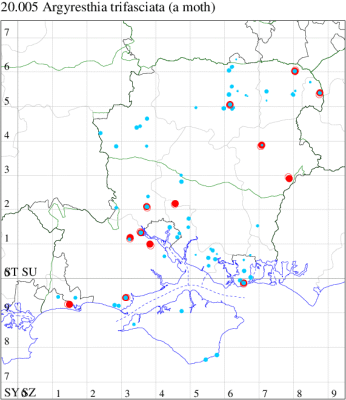
Records by year
Records by week (adult)
Records by week (larval)
Record Details
VC11: Marchwood*, one, 26 May (CTh); Woodlands, New Forest, present, 09 May (RBW); Totton, two, 25 Apr; one, field observation, 25 Apr; one, 02 May; one, 03 May; one, 08 May; five, 15 May; two, 16 May; one, 17 May; two, 18 May; one, 19 May; three, 21 May; one, 22 May; two, 23 May; one, 24 May; one, 22 Jun; one, 09 Jul; three, 15 Jul; two, 16 Jul; one, 17 Jul; one, 19 Jul; one, 20 Jul; one, 23 Jul (LH); Romsey, one, 08 May; one, 18 May; one, 26 May (MB); Southampton, one, 16 May (MEdg); Eastleigh, one, to actinic, 16 May; one, to actinic, 18 May (KArb); Allbrook, one, 01 Jun (SI); Tuckton, Bournemouth, one, 27 May (APar); Pennington, one, 07 Aug; one, 08 Aug (RFC); Southsea, one, 22 Apr; one, 23 Apr; one, 02 May; one, 07 May; one, 15 May; one, 27 May (JRL);
VC12: Anna Valley, Andover, one, 21 May; one, 26 May (TJN); Basingstoke, one, 09 May; three, 19 May; one, 26 May (RHil); Warren Hill, Liss Forest*, one, 30 May (RJM); Alton, one, netted, 19 May (BCA); Farnborough, one, 09 May; one, 16 May; two, 18 May; six, 21 May; three, 26 May; one, 29 May (KBW); Yateley, two, 23 Apr; one, 29 Apr; 12, 02 May; 18, 03 May; 15, 07 May; 10, 09 May; two, 15 May; seven, 19 May; one, 26 May (JHH)
20.007 [B&F: 0409b] Cypress Tip Moth Argyresthia cupressella Walsingham, 1890 - Local
Local in gardens throughout East Anglia, and northern and western England. An adventive species, recorded nationally for the first time in 1997 in Suffolk, the Cypress Tip Moth is now fully naturalised following its accidental introduction on coniferous trees. Has been recorded increasingly in Hampshire and on the Isle of Wight. Wingspan 8-9 mm. Larva mines young shoots of Juniper, Leyland Cypress and Lawson's Cypress.
Records prior to 2020
| Vice County | #Records | #Individuals | First Record | Last Record |
|---|---|---|---|---|
| 10 | 43 | 54 | 2008 | 2019 |
| 11 | 456 | 1054 | 2002 | 2019 |
| 12 | 10 | 15 | 2010 | 2018 |
2020 records
| Vice County | #Records | #Individuals | Max Quantity |
|---|---|---|---|
| 10 | 4 | 4 | 1 |
| 11 | 62 | 122 | 11 |
| 12 | 1 | 1 | 1 |
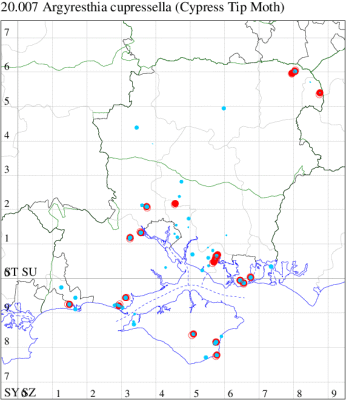
Records by year
Records by week (adult)
Records by week (larval)
Record Details
VC10: Bonchurch, one, 02 Jun (JHa); Rookley, one, 30 May; one, to actinic, 08 Jun (JBa); Shanklin, one, 15 Jun (IOu);
VC11: Woodlands, New Forest, present, 04 Jul (RBW); Totton, one, 08 May; one, 15 May; two, 19 May; one, 20 May; eight, 21 May; five, 22 May; one, 26 May; one, 28 May; one, 29 May; one, 30 May; two, 31 May; four, 01 Jun; one, 02 Jun; two, 07 Jun; three, 13 Jun; one, 15 Jun; one, 16 Jun; one, 17 Jul (LH); Romsey, two, 26 May; two, 30 May; one, 01 Jun (MB); Allbrook, one, 21 May; one, 07 Jun (SI); Fareham, one, 16 May (ADT); one, 16 Jun (IMcP); one, to actinic, 01 Jun; one, to actinic, 08 Jun; one, to actinic, 09 Jun; one, to actinic, 02 Jul (MLO); one, to malaise trap, 08 May (RJD); Portsmouth, one, 18 May; one, 19 May; three, 26 May (IRT); Tuckton, Bournemouth, two, 02 Jun (APar); Sway, one, 19 May; three, 26 May; one, 27 May; two, 01 Jun; two, 02 Jun; one, 14 Jun (SKe); Milford on Sea, one, 08 Jun (MMcM); Pennington, two, 21 May; one, 27 May; three, 02 Jun; one, 17 Jun; one, 24 Jun (RFC); Southsea, one, 10 May; one, 18 May; one, 31 May; one, 07 Jun; one, 14 Jun; one, 15 Jun (JGe); two, 15 May; one, 16 May; two, 18 May; five, 19 May; seven, 20 May; 11, 21 May; one, 24 May; four, 25 May; eight, 26 May; two, 27 May; two, 29 May; one, 30 May; one, 31 May; two, 01 Jun; present, 02 Jun (JRL);
VC12: Anna Valley, Andover, two, 02 Jun (TJN); Castle Bottom NNR*, present, netted, 18 May (JHH); Farnborough, one, 21 May (KBW); Yateley, one, 15 May; one, 08 Jun; two, 26 May; one, 31 Jul (JHH)
20.010 [B&F: 0409] Argyresthia ivella (Haworth, 1828) - Nationally Scarce B
A rarely encountered insect associated with orchards, and also on isolated wild apple trees, in England and Wales, as far north as Northumberland (MBGBI Vol 3). In Hampshire apparently formerly fairly widespread, but in recent years has only been reported sporadically. First recorded on the Isle of Wight at Newtown in 2011. Wingspan 10-12 mm.
Interestingly, the specific name ivella was coined as Haworth saw the Roman numerals 'IV' in the wing markings.
Despite what is quoted in most literature, the caterpillar of this species still seems to be largely unknown and like many species, references are handed down based on dubious sources: in MoGBI, the larva is said to feed on apple and hazel, but it appears that this is not based on primary information. Friese (1973: 733) urged his lepidopterologist colleagues: "Collectors should pay particular attention to this...rarely found species; further observations to clarify the biology would be very desirable. As with A. retinella, care must be taken to ensure that "The plant on which the butterflies are found does not have to be identical to the food plant for the caterpillars." A request that remains unchanged half a century later.
Records prior to 2020
| Vice County | #Records | #Individuals | First Record | Last Record |
|---|---|---|---|---|
| 10 | 2 | 2 | 2011 | 2011 |
| 11 | 19 | 18 | 1900 | 2015 |
| 12 | 10 | 6 | 1960 | 2018 |
2020 records
| Vice County | #Records | #Individuals | Max Quantity |
|---|---|---|---|
| 12 | 1 | 1 | 1 |

Records by year
Records by week (adult)
Records by week (larval)
Record Details
VC12: Axmansford*, one, 13 Jul (ACB det. GJD)
20.011 [B&F: 0410] Argyresthia brockeella (Hübner, [1813]) - Common
Common in open, especially birch, woodland and freshwater margins throughout the British Isles. Widespread and common in Hampshire and the Isle of Wight. Wingspan 10-12 mm. Variable, but only the scarce unicolorous form problematic, being similar to the unicolorous form of A. goedartella, but a deeper, darker colour than A. goedartella. Flies in afternoon sunshine and at night. Larva mines young shoots and catkins of Silver and Downy Birch, and Alder.
Records prior to 2020
| Vice County | #Records | #Individuals | First Record | Last Record |
|---|---|---|---|---|
| 10 | 49 | 81 | 1997 | 2019 |
| 11 | 749 | 1038 | 1972 | 2019 |
| 12 | 233 | 454 | 1974 | 2019 |
2020 records
| Vice County | #Records | #Individuals | Max Quantity |
|---|---|---|---|
| 10 | 3 | 3 | 1 |
| 11 | 8 | 8 | 1 |
| 12 | 6 | 8 | 2 |

Records by year
Records by week (adult)
Records by week (larval)
Record Details
VC10: Shanklin, one, 24 Jun; one, 25 Jun; Firestone Copse, one, 21 Jul (IOu);
VC11: Marchwood, one, 24 Jun (CTh); Totton, one, 09 Aug (LH); Romsey, one, 23 Jun; one, 08 Aug (MB); one, 19 Jun (NRJ); Southampton, one, 29 Jun (MEdg); West End, one, 16 Jul (PAB); Wickham, one, 24 Jun; one, 21 Jul (JRDS); Burton, nr Christchurch, one, 26 May (JSw); Sway, one, 28 May; one, 29 Jun; one, 02 Jul (SKe);
VC12: Cholderton, one, 10 Jul; one, 17 Jul; two, 24 Jul (TJN, HE); Anna Valley, Andover, one, 25 Jun (TJN); Axmansford, one, 23 Jul (ACB); Basingstoke, one, 23 Jul (MJW); Pamber Forest, one, 08 Jun; two, 17 Jun; one, 01 Jul; two, 13 Jul (GJD); Castle Bottom NNR, present, 25 Jun (JHH, AMD)
20.012 [B&F: 0411] Argyresthia goedartella (Linnaeus, 1758) - Common
Common in open woodland, heathland, gardens and freshwater margins throughout the British Isles. Widespread and common in Hampshire but apparently rarer on the Isle of Wight. Wingspan 10-12 mm. Generally a fairly distinctive species, but variable, with plain forms difficult to distinguish from plain forms of A. brockeella, which see. Larva mines young shoots and catkins of Silver and Downy Birch, and Alder.
Records prior to 2020
| Vice County | #Records | #Individuals | First Record | Last Record |
|---|---|---|---|---|
| 10 | 52 | 83 | 1977 | 2019 |
| 11 | 1332 | 2807 | 1969 | 2019 |
| 12 | 550 | 1623 | 1975 | 2019 |
2020 records
| Vice County | #Records | #Individuals | Max Quantity |
|---|---|---|---|
| 10 | 2 | 3 | 2 |
| 11 | 57 | 115 | 13 |
| 12 | 28 | 139 | 55 |

Records by year
Records by week (adult)
Records by week (larval)
Record Summary
VC10: Earliest: Shanklin, 25 Jun, 1 (IOu) Latest: Shanklin, 09 Aug, 2 (IOu) Max count: Shanklin, 09 Aug, 2 (IOu)
VC11: Earliest: West Walk, 01 Jun, 1 (RJD) Latest: Marchwood, 19 Sep, 1 (CTh) Max count: Romsey, 08 Aug, 13 (MB)
VC12: Earliest: Basingstoke, 29 May, 1 (MJW) Latest: Pamber Forest, 07 Sep, 1 (GJD) Max count: Pamber Forest, 31 Jul, 55 (GJD)
20.015 [B&F: 0414] Argyresthia curvella (Linnaeus, 1761) - Local
Local in gardens and orchards throughout England and Wales, extending to Perthshire and the Western Isles in Scotland (MBGBI Vol 3). In Hampshire rather uncommon, given its reputation as a pest in orchards, but perhaps under-recorded: the first records for the Isle of Wight since 1925 were reported in 2022. Wingspan 10-12 mm. Similar to A. sorbiella, from which it is distinguished by its smaller size and the colour of the markings which are almost greyish brown on a clear white ground colour (MBGBI Vol 3). Larva mines buds and shoots of Apple, causing sufficient damage to be a serious pest in some areas, over-wintering as an egg.
Records prior to 2020
| Vice County | #Records | #Individuals | First Record | Last Record |
|---|---|---|---|---|
| 11 | 29 | 86 | 1936 | 2018 |
| 12 | 19 | 16 | 1980 | 2017 |
2020 records
| Vice County | #Records | #Individuals | Max Quantity |
|---|---|---|---|
| 12 | 1 | 1 | 1 |
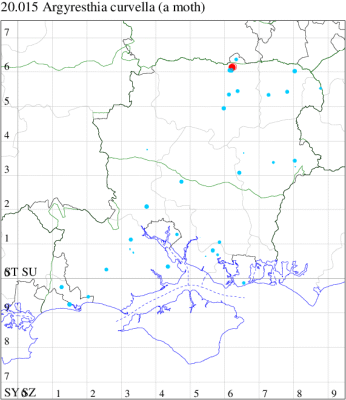
Records by year
Records by week (adult)
Records by week (larval)
Record Details
VC12: Pamber Forest, one, 15 Jun (GJD)
20.016 [B&F: 0415] Argyresthia retinella Zeller, 1839 - Common
Common in open woodland throughout the British Isles. Reasonably common in Hampshire, but rarely record on the Isle of Wight. Wingspan 9-10 mm. Flies in afternoon sunshine and at night. Characterised by white forewing, irregularly strigulate dark brown; a diffuse brownish streak from base to disc beneath subcostal vein; a large diffuse dark brown spot in disc; a diffuse terminal streak; apical dot blackish brown (MBGBI Vol 3). Larva mines the shoots and catkins of Birch.
Records prior to 2020
| Vice County | #Records | #Individuals | First Record | Last Record |
|---|---|---|---|---|
| 10 | 1 | 1 | 1978 | 1978 |
| 11 | 168 | 384 | 1972 | 2019 |
| 12 | 76 | 117 | 1974 | 2019 |
2020 records
| Vice County | #Records | #Individuals | Max Quantity |
|---|---|---|---|
| 12 | 5 | 6 | 2 |

Records by year
Records by week (adult)
Records by week (larval)
Record Details
VC11: Sway, one, photo?, 01 Jun (SKe);
VC12: Pamber Forest, one, field observation, 08 Jun; two, 08 Jun; one, 10 Jun; one, 17 Jun; one, 23 Jun (GJD)
20.018 [B&F: 0417] Argyresthia spinosella Stainton, 1849 - Common
Common in hedgerows throughout much of the British Isles, except for the Highlands and Islands of Scotland. In Hampshire most frequent in the south-east of the county, with scattered records elsewhere and on the Isle of Wight. Wingspan 9-11 mm. The main confusion species are Apple Fruit Moth A. conjugella and A. semifusca, which see. Larva mines buds and shoots of Blackthorn, over-wintering as an egg.
Records prior to 2020
| Vice County | #Records | #Individuals | First Record | Last Record |
|---|---|---|---|---|
| 10 | 27 | 33 | 1900 | 2019 |
| 11 | 233 | 239 | 1973 | 2019 |
| 12 | 39 | 43 | 1996 | 2018 |
2020 records
| Vice County | #Records | #Individuals | Max Quantity |
|---|---|---|---|
| 10 | 1 | 0 | 0 |
| 11 | 3 | 3 | 1 |
| 12 | 3 | 4 | 2 |

Records by year
Records by week (adult)
Records by week (larval)
Record Details
VC10: Cranmore, present, to actinic, 30 May (CHic);
VC11: Allbrook, one, 26 May (SI); Fareham, one, to actinic, 15 Jun (MLO); Pennington, one, 29 May (RFC);
VC12: Basingstoke, one, 01 Jun (MJW); Pamber Forest, two, 25 May; one, 08 Jun (GJD); Yateley, one, 26 May (JHH)
20.019 [B&F: 0418] Apple Fruit Moth Argyresthia conjugella Zeller, 1839 - Common
Common in orchards and woodland throughout the British Isles, more numerous in the north. Rather uncommon in Hampshire. Not recorded from the Isle of Wight to date. Wingspan 10-14 mm. Day-flying, but may come to light. Similar species include A. spinosella, from which A. conjugella is distinguished by the ochreous tinge of its ground colour, slightly larger size and later flight time; and A. semifusca from which A. conjugella is distinguished by its more marbled markings and ochreous ground colour. Larva mines fruit and berries of Apple and Rowan, causing sufficient damage to be a serious pest in some area, and over-wintering as a pupa in a cocoon.
Records prior to 2020
| Vice County | #Records | #Individuals | First Record | Last Record |
|---|---|---|---|---|
| 10 | 6 | 11 | 2017 | 2017 |
| 11 | 40 | 50 | 1985 | 2017 |
| 12 | 29 | 31 | 1997 | 2018 |
2020 records
| Vice County | #Records | #Individuals | Max Quantity |
|---|---|---|---|
| 10 | 3 | 5 | 3 |
| 11 | 1 | 0 | 0 |
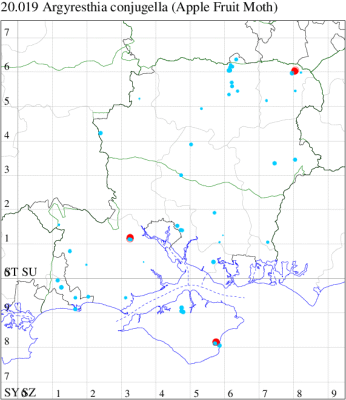
Records by year
Records by week (adult)
Records by week (larval)
Record Details
VC10: Shanklin, one, gen det, 21 May; three, gen det, 26 May; one, 08 Jun (IOu);
VC11: Woodlands, New Forest, present, 19 May (RBW);
VC12: Yateley*, one, 19 May; one, 20 Jun (JHH det. JHH. AMD)
20.020 [B&F: 0419] Argyresthia semifusca (Haworth, 1828) - Common
Common in open woodland and hedgerows throughout the British Isles, less numerous in the south. In Hampshire it has perhaps been under-recorded in the past, but not uncommon in the north-east of the county. Not recorded from the Isle of Wight to date. Wingspan 10-13 mm. Main confusion species are Apple Fruit Moth A. conjugella, which is generally more ochreous and marbled, and A. spinosella, from which A. semifusca distinguished only with certainty by dissection of the genitalia. Larva mines shoots of Rowan and, in the south of Britain, predominately Hawthorn.
Records prior to 2020
| Vice County | #Records | #Individuals | First Record | Last Record |
|---|---|---|---|---|
| 10 | 3 | 3 | 1900 | 2018 |
| 11 | 56 | 51 | 1972 | 2015 |
| 12 | 44 | 64 | 1990 | 2019 |
2020 records
| Vice County | #Records | #Individuals | Max Quantity |
|---|---|---|---|
| 11 | 8 | 8 | 1 |

Records by year
Records by week (adult)
Records by week (larval)
Record Details
VC11: Romsey, one, 18 May; one, 19 May; one, 28 May (NRJ); Winchester, one, 26 May (THW); Tuckton, Bournemouth, one, 27 May (APar)
20.021 [B&F: 0420] Cherry Fruit Moth Argyresthia pruniella (Clerck, 1759) - Common
Common in gardens, woodland and orchards throughout the British Isles. Fairly well distributed in Hampshire, but recorded very infrequently on the Isle of Wight. Wingspan 10-12 mm. The main confusion species is A. bonnetella, which see for differences. Larva mines shoots and fruits of Cherry, including wild, ornamental and cultivated varieties, causing sufficient damage to be a serious pest in some areas, and over-wintering as an egg or small larva.
Records prior to 2020
| Vice County | #Records | #Individuals | First Record | Last Record |
|---|---|---|---|---|
| 10 | 11 | 8 | 1900 | 2019 |
| 11 | 212 | 232 | 1974 | 2019 |
| 12 | 75 | 86 | 1981 | 2019 |
2020 records
| Vice County | #Records | #Individuals | Max Quantity |
|---|---|---|---|
| 11 | 7 | 7 | 1 |
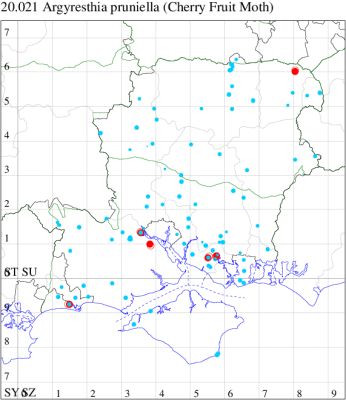
Records by year
Records by week (adult)
Records by week (larval)
Record Details
VC11: Marchwood*, one, 24 Jun (CTh); Totton, one, 04 Aug (LH); Catisfield, one, to actinic, 25 Jun (ALR); Fareham, one, to actinic, 02 Jul (MLO); Tuckton, Bournemouth, one, 23 Jun; one, 08 Aug; one, 09 Aug (APar);
VC12: Cholderton, one, 17 Jul; one, 31 Jul; one, 08 Aug (TJN, HE); Anna Valley, Andover, one, 20 Jul (TJN); Yateley*, one, 31 Jul; one, 08 Aug; one, 08 Sep (JHH)
20.022 [B&F: 0421] Argyresthia bonnetella (Linnaeus, 1758) - Common
Common wherever the foodplant occurs, in hedgerows, gardens, downland and scrub throughout the British Isles. Widespread and common in Hampshire and on the Isle of Wight. Wingspan 9-11 mm. The main confusion species is Cherry Fruit Moth A. pruniella — both species show a pale dorsal streak, but differ in the angle made by the prominent brown fascia — in both species the fascia starts from mid-way along the dorsum, but the angle between the fascia and the dorsum is about 45° in A. pruniella and 30° in A. bonnetella. Larva mines bark of Hawthorn.
Records prior to 2020
| Vice County | #Records | #Individuals | First Record | Last Record |
|---|---|---|---|---|
| 10 | 17 | 45 | 1900 | 2019 |
| 11 | 190 | 333 | 1932 | 2019 |
| 12 | 76 | 108 | 1960 | 2019 |
2020 records
| Vice County | #Records | #Individuals | Max Quantity |
|---|---|---|---|
| 10 | 4 | 6 | 3 |
| 11 | 1 | 1 | 1 |
| 12 | 3 | 3 | 1 |

Records by year
Records by week (adult)
Records by week (larval)
Record Details
VC10: Bonchurch, one, 21 May; one, 27 May; one, 25 Jun (JHa); Shanklin*, three, 30 Jul (IOu);
VC11: Southampton, one, 14 Aug (MEdg); Fareham, one, to actinic, 09 Aug (MLO);
VC12: Preston Candover, one, 07 Aug (MJW); Pamber Forest, one, 31 Jul; one, 10 Aug (GJD); Yateley*, two, 17 Aug (JHH)
20.023 [B&F: 0422] Argyresthia albistria (Haworth, 1828) - Common
Common in hedgerows and scrub throughout the British Isles. Widespread and common in Hampshire and on the Isle of Wight. Wingspan 9-11 mm. Occurs in two forms, a unicolorous form, which is similar to the unicolorous form of Apple Fruit Moth A. conjugella, but with head white in A. albistria, and the nominate form, which is similar to A. semifusca, but smaller and brighter. Larva mines flowering shoots of Blackthorn, over-wintering as a small larva.
Records prior to 2020
| Vice County | #Records | #Individuals | First Record | Last Record |
|---|---|---|---|---|
| 10 | 47 | 85 | 1900 | 2019 |
| 11 | 221 | 223 | 1973 | 2019 |
| 12 | 47 | 49 | 1967 | 2019 |
2020 records
| Vice County | #Records | #Individuals | Max Quantity |
|---|---|---|---|
| 10 | 8 | 10 | 3 |
| 11 | 3 | 3 | 1 |
| 12 | 3 | 3 | 1 |

Records by year
Records by week (adult)
Records by week (larval)
Record Details
VC10: West High Down Quarry, one, 20 Aug; Haseley Manor, one, 11 Aug; Shanklin, one, gen det, 26 Jul; one, 06 Aug; one, 13 Aug; three, 14 Aug; one, 20 Aug; one, 08 Sep (IOu);
VC11: Winchester, one, 14 Aug (THW); Fareham, one, to actinic, 16 Jul (MLO); Hilltop, The Hangers, one, 01 Aug (SI); Old Winchester Hill, one, field observation, 01 Aug (JHH, AMD det. JHH);
VC12: Over Wallop*, one, 27 Aug (CM); Cholderton, one, 08 Aug (TJN, HE); Axmansford*, one, 23 Jul (ACB det. GJD); Pamber Forest, one, 07 Sep (GJD)

()(IMG_5363).jpg)